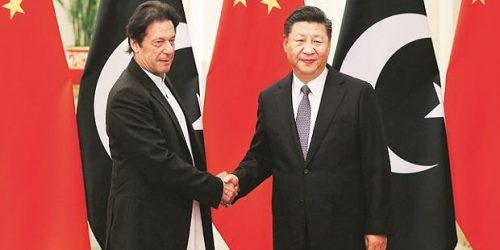In China’s debt-trap diplomacy, Pakistan is struggling to repay loans for power projects under President Xi Jinping’s Belt and Road Initiative (BRI) and seeks to reschedule as much as USD 22 billion in outstanding credits.
In recent years, Chinese loans have fueled a massive buildout of Pakistan’s power generation, financing that has turned a perennial electricity shortfall into a now-massive capacity surplus that the highly indebted nation can increasingly ill-afford, Asia Times reported.
In those debt-rescheduling talks, Pakistani officials are also reportedly asking their Chinese counterparts to decelerate agreed plans to build even more power plants that would add to the overcapacity problem.
“Yes, we have accelerated efforts to get some sort of relaxation from Beijing either in the power purchase mechanism or on the mode of payment of capacity cost,” Asia Times quoted the source as saying.
According to the source, a high-level delegation led by Pakistani President Arif Alvi visited Beijing last March to discuss the possibility of a 2.5 per cent cut in the present interest rate on power sector-related loans at Libor plus 4.5 per cent.
“[Alvi] also discussed with his Chinese counterpart a 10-year extension in the debt repayment period. These two rebates, if approved, would save [Pakistan] about USD 600 million annually,” said the source.
The Pakistani government has recently reapproached Chinese officials on the issue but no information has leaked out in the public domain on their exchanges, reported Asia Times.
“First, the power purchase agreements made with Beijing provide for a highly overrated power supply, which eats up roughly USD 1.6 billion annually. Another USD 1.8 billion goes into power pilferage and line losses, and yet another USD 9 million is consumed in recovery losses of power dues from consumers,” Asia Times quoted Dr Farrukh Saleem, an Islamabad-based political economist, analyst, and columnist, citing official statistics on power sector losses incurred by the state.
Saleem said that the recent COVID-influenced downturn in gross domestic product growth from 5.8 per cent in 2018 to -0.4 per cent in 2020, the first time Pakistan’s economy dipped into negative growth in over seven decades, has curtailed electricity demand across the country.
“This rendered thousands of megawatt electricity surplus, on which the government pays capacity charges in line with the agreements,” Saleem added.
Experts say that if the current overcapacity problem and debt repayment terms persist, the government’s overall power sector liability may balloon beyond 1.5 trillion rupees (USD 9.4 billion) by the end of 2023, reported Asia Times.
Asia Times further reported that official estimates indicate that Pakistan’s energy-related debts will rise to 2.8 trillion (USD 17.5 billion) rupees by the end of June under current Belt and Road terms and conditions. The figures show that power sector liabilities surged by 538 billion rupees (USD 3.4 billion) in just one year from July 2019 to June 2020.
Official figures indicate that Pakistan’s total debt servicing liability could surpass USD 14 billion by the end of the year, at a time foreign exchange reserves are hovering around USD 13 billion.
That’s leading some analysts to the conclusion that China’s Belt and Road lending to Pakistan is becoming a “debt trap”, as total external debts and liabilities hit USD 115.76 billion at the end of 2020 and more owed in 2021 for what are now seen as unproductive Chinese power sector investments, Asia Times reported.
(Only the headline and picture of this report may have been reworked by the Business Standard staff; the rest of the content is auto-generated from a syndicated feed.)






